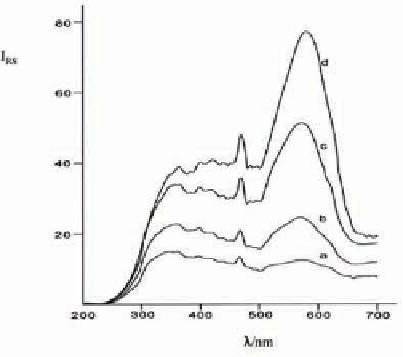Biomedical Engineering Reference
In-Depth Information
spectroluorometer, are practical for the determination of human
immunoglobulin (IgG), based on analyte induced aggregation of
goat-anti-human IgG-functionalized Au NPs.
47
Upon increasing
IgG concentration over a dynamic range of 0.05-10 μg/mL, the
RLS of bioconjugated Au NPs increases. The immunoassay can be
accomplished in a homogeneous solution for the determination
of human IgG in serum samples with one-step operation in under
10 min, and provides results that are consistent with those obtained
by conducting an enzyme-linked immunosorbent assay. Detection
of trace immunoglobulin M (IgM) using Au NPs (8 nm diameter)
bioconjugated with goat antihuman immunoglobulin M (Au-GIgM)
is also represented.
48
Aggregates form due to the interaction of Au-
GIgG with IgM in KH
2
PO
4
-Na
2
HPO
4
buffer (pH 4.9) containing PEG-
6000, leading to an increased RLS intensity at 580 nm. The enhanced
RLS intensity at 580 nm is proportional to the IgM concentration
over the concentration range of 1.5-2000 ng/mL. The RLS approach
is sensitive (LOD = 0.98 ng/mL) for IgM.
Figure 8.9
RLS spectra of gold-labeled goat anti-human ApoAI antiserum
and ApoAI. Traces: (a) PB solution (pH 6.4) containing 23.18
mg/L goat anti-human ApoAI antiserum and 75 g/L PEG-
6000; (b) PB solution (pH 6.4) containing 23.18 mg/L goat
anti-human ApoAI antiserum, 0.033 mg/L ApoAI, and 75 g/L
PEG-6000; (c) PB solution (pH 6.4) containing 23.18 mg/L
goat anti-human ApoAI antiserum, 0.17 mg/L ApoAI, and
75 g/L PEG-6000; (d) PB solution (pH 6.4) containing 23.18
mg/L goat anti-human ApoAI antiserum, 0.33 mg/L ApoAI, and
75 g/L PEG-6000. Reprinted from Ref. 45 with permission.


Search WWH ::

Custom Search